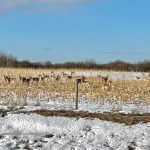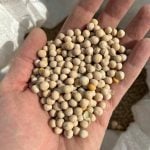When The 100-Mile Diet was topping bestseller lists in North America, the reaction of Canada s commercial-scale farmers barely rose to an apathetic OK, but so what?
Most of our farmers after all are in the business of producing wholesome and affordable products that are then shipped as bulk commodities to distant cities or around the globe. Even the domestic supply management system is bulk oriented, with just a handful of dairies processing most of the milk across the nation.
Local food might perhaps make an interesting discussion topic. It might even be a bit of a threat, but few farmers were going to waste time thinking about it, especially when it had all the earmarks of a flash-in-the-pan trend.
Read Also

The big squeeze: How to be fair to siblings during farm succession
Managing sibling business relationships on family farms.
And then of course there is the cold Canadian reality, something our farmers understand only too well, and which they captured with the frequently heard rhetorical question: A 100-mile diet? Won t that be pretty bland in January?
In 2005 Saskatchewan-based journalist, writer and one-time Prairie farm kid Amy Jo Ehman set out to answer that question and write about it in the book Prairie Feast A Writer s Journey Home for Dinner (Coteau Books, 2010). Country Guide spoke to Ehman recently about what the growing consumer interest in food means for farms, and to ask more about why she believes every type of farm from large export-oriented operations to small local U-picks needs and deserves your respect.
COUNTRY GUIDE: Tell us about your background as a kid from a farm who moved to the city, went to university and became a journalist. How does that dual life story change how you look at food?
AMY JO EHMAN: I grew up on a grain farm that was considered a larger operation by the standards of the day 3-1/2 sections (2,240 acres) near Craik, Sask., which is about halfway between Regina and Saskatoon on the main highway between the two cities. My parents farmed there and my brother Tom still farms there today.
When I left the farm I moved to the city, where I worked primarily in broadcasting with the CBC. In 2000 I began working as a freelancer for a number of different outlets, and in 2005 my husband and I decided we would eat only Saskatchewan food products for a year. I approached the SASKATOON STAR PHOENIX about writing a monthly column while doing it, and they agreed, but the column continues even today, so I guess I ve become their local food columnist. When that year was up, I started writing a book.
What I found was, even though I was fortunate enough to have a family farm to go back to, I didn t really have much connection to food and agriculture. I felt quite disconnected from it, even though I was right here in the agricultural heartland of Canada.
CG: So as you were exploring that gap, what were some of the biggest surprises from both of these perspectives someone from the farm and at the same time a consumer looking for more information?
EHMAN: From the perspective of someone from the city, I was surprised by the wide variety of food products you could find locally if you were willing to look for them. For example, I didn t know about spice production in Saskatchewan. I d heard of the mustard industry, of course, and I knew that Saskatchewan was the world s largest producer of mustard. But I didn t know we also grew spices like cumin and coriander. Or another specific example of a discovery was the fish farm on Lake Diefenbaker, which I found out is the largest freshwater trout farm in the country.
I was also very surprised just how hard it was to find any information from a consumer perspective. Most of the websites I found, for example, talked a lot about producing the crops and marketing the crops and the value of the crops. There wasn t much out there in terms of information to consumers, though there were some industry groups that seem to be doing a very good job, Pulse Canada, for example. The canola industry does some too. But generally, you had to be a bit of a sleuth to find out about what was available.
I was really surprised about how little marketing seems to be done towards consumers.
CG: What do farmers need to understand better about consumers to connect better with them? And why should larger, perhaps export-oriented producers care about this?
EHMAN: Right now there is a very strong ethic towards food patriotism. People want food that is produced in their local area. They want to know about that food. If you start a dialogue with them, and tell them about what you re doing, I think that would be a very good thing.
It s true, if you re someone who s producing primarily for export these consumers may not ever be major customers of yours we do produce and export a lot of food from this region. But they might become your allies, and that s important.
Consumers have a lot of clout, both in the marketplace and politically.
CG: I ve talked to people who seem to find it all a bit threatening. At times it almost seems like an attack on what they ve been doing. Have you noticed this?
EHMAN: I can honestly say that I ve never really encountered that attitude you re talking about. I ve found people to be very open and interested in this, even some of the large farmers I ve spoken to who export a lot of product around the world. They may not think it s a market for them and their farm, but they re still very interested in hearing about it.
CG: What s your key message to farmers who want to understand consumers better? To me it seems they re looking for something any good capitalist could understand better information on the market to make their decision.
EHMAN: I like that that s certainly what I m after. I think what more and more consumers are looking for are better choices and easier choices in the marketplace. For example, it s easier to buy New Zealand lamb than Saskatchewan lamb at the grocery store. At best you can get lamb that s raised locally but sent elsewhere for processing and labelled Canadian lamb there isn t a single federally inspected processing facility for lamb in Saskatchewan. I think you can expect to see more engagement with policy-makers like politicians and distributors including grocers aimed at getting better access to these choices.
CG: Just in conclusion, what can you tell us about eating a Saskatchewan-based diet? What was it like?
EHMAN: It was really good. I never set out with the intention of denying ourselves good and tasty food and I found, once I d done a bit of research, that there were tremendous choices available. I just had to go and find them. In fact, when the year was up, I didn t really quit, though I wasn t as strict about it. I ll buy bananas now, for example. But most nights when we sit down for dinner, you ll find that the majority of our meal comes from local sources.CG















